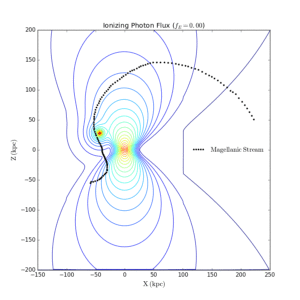An explosion at the centre of our Galaxy
A new study led by SIfA professor Joss Bland-Hawthorn shows evidence that a huge explosion occurred at the centre of our Galaxy. This explosion was so powerful that it could only have come from one thing: the supermassive black hole today lying dormant in the middle of our galaxy, Sagittarius A*.
“The black hole, of course, is invisible, nothing gets out,” explained Prof Joss Bland-Hawthorn
“But before stuff falls in, it spins in this death spiral around the black hole. It’s called an accretion disc, and we know these generate enormous winds, jets, and bubbles.”
In a new paper to be published by The Astrophysical Journal next month, Prof. Bland-Hawthorn and his team describe new evidence on how the flare from the explosion influenced the Galactic neighborhood. So powerful was the flare that it impacted on the Magellanic Stream—a long trail of gas extending from nearby dwarf galaxies called the Large and Small Magellanic Clouds. The Magellanic Stream lies at an average 200,000 light-years from the Milky Way and today it provides the fossil imprints of such powerful explosion.
Together with jets and bubbles, the explosion generates beams of ionising radiation, which look like a lighthouse beacon coming out of the north and south galactic poles. This radiation reached the Magellanic Stream, heating up the gas to much higher temperatures.
The animation below explains how the ionising radiation reached the Magellanic Stream.

“This is a dramatic event that happened a few million years ago in the Milky Way’s history,” says Professor Lisa Kewley, Director of ASTRO 3-D.
“A massive blast of energy and radiation came right out of the galactic centre and into the surrounding material. This shows that the centre of the Milky Way is a much more dynamic place than we had previously thought. It is lucky we’re not residing there!”
The story attracted a lot of attention from the media and it has spread across several countries.
Read the full discussion about the results on The Conversation: A dormant volcano: the black hole at the heart of our galaxy is more explosive than we thought

